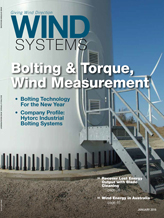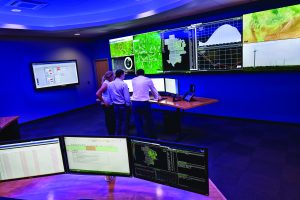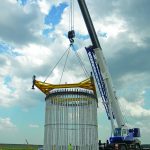While it may seem like a hindrance to incorporate new technology, electronic torquing is easier to use and boasts undeniably better results. If you do not torque correctly, accurately, or with repeatability, you cannot do anything else. From the basement to the blade bolts and everything in between, you have to be certain that you are achieving the correct torque that has been designated.
Efficiency is king when it comes to scheduled maintenance, and hydraulics no longer wear the crown. For example, in the same amount of time it takes to set up, torque a tower section, and prepare for the next section with hydraulics, all tower sections could be torqued. Each bolt would be recorded automatically with the exact torque applied, and the technician would not need to make a costly trip to the chiropractor before hitting the yaw deck.
New tooling varieties such as the E-RAD BLU and Smart Socket technology make it more appealing to all site personnel, from the project manager having exact readings and torque transmitted via Bluetooth when he wants, to the wind technician that has effectively lost more than 50 pounds of bulky bolting hydraulic equipment. Smaller footprints mean more production and faster deadlines. You have to be certain that you are achieving the correct torque that the OEM has designated. Too much, and you would have fatigued the jointed material and bolt; too little, and it rattles, becoming loose. Accidentally turning the knob on a hydraulic pump can exponentially increase the hydraulic tools torque and leave you with a sheered bolt wreaking havoc in the hub or worse.
 There are some key differences between hydraulic and electronic wrenches. Electronic precision torque wrench tools, for example, are designed to provide a high degree of accuracy, plus or minus 2.8 percent, and repeatability of plus or minus 2 percent using a more efficient planetary gearbox design and the precision of an electric AC servo motor. Having control with the touch of a finger further demonstrates the increasing differences from the hydraulic predecessors.
There are some key differences between hydraulic and electronic wrenches. Electronic precision torque wrench tools, for example, are designed to provide a high degree of accuracy, plus or minus 2.8 percent, and repeatability of plus or minus 2 percent using a more efficient planetary gearbox design and the precision of an electric AC servo motor. Having control with the touch of a finger further demonstrates the increasing differences from the hydraulic predecessors.
Risk mitigation is also deeply engrained within hydraulic torque wrench alternatives that could not be implemented into hydraulic power pack systems. Introducing an engineering control for safety trumps individual personal protective equipment and costly equipment training. For example, with electronic torque wrench systems, the tool operates at extremely low noise levels at only 75 decibels, meaning you can be safer knowing you will hear your radio when the booming and unforgiving weather conditions such as thunder and lightning comes unexpectedly.
Data collection software allows for the most absolute traceability and transcription of data in a simple plug-and-play or wireless connection. With safety and risk management being the biggest concern, electronic torque wrenches have LED indicator lights such as pass or fail located on both sides. These visual signals indicate the status of torque procedure for maximum accuracy as well as fast and convenient error-free digital single increment torque settings.
The wind industry is consistently improving for the better. Electronics are now becoming the go-to choice due to their accuracy and repeatability. From years of calibrating hydraulic tooling in an ISO/IEC 17025:2005-accredited hydraulic calibration laboratory, most hydraulic wrenches have an OEM-specified accuracy of 5 percent. While this is a good standard, it is only 50 percent as accurate of what electronic torque wrenches are capable of. Hydraulic tooling kits has to either be flown up in a box (if the specific model supports an outward hoist) or carried. The setup alone for torquing with hydraulic wrenches can be more than the time it takes to accomplish the task at hand. Electronic torque wrenches clearly surpass the equivalent tooling that would be needed by hydraulics for speed. Instead of using a pen and some paper, you can simply press a button on a calculator, eliminating that possibility for error.


































